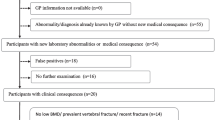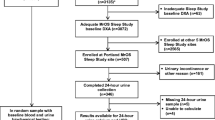Abstract
Clinicians regularly order laboratory tests in women with osteoporosis to assess if an underlying medical condition is contributing to bone loss. To determine which laboratory tests are associated with osteoporosis we conducted a secondary analyses of data collected as part of the Fracture Intervention Trial (FIT), which included 15,316 postmenopausal women. Women had tests of liver and kidney function, mineral metabolism, electrolytes and complete blood count, femoral neck and total body BMD and spinal radiographs. The prevalence of abnormal tests in women with osteoporosis compared to women without was not different, except for low TSH (<0.5 IU/ml). Among women with and without osteoporosis at the femoral neck the prevalence of low TSH was 4.9% (95% CI: 4.4–5.5) and 3.7% (95% CI: 3.3–4.1), respectively, yielding a positive likelihood ratio of 1.2 (95% CI: 1.1–1.3). We observed similar results for women with vertebral fractures compared to women without vertebral fractures; positive likelihood ratio of 1.4 (95% CI: 1.3–1.6). Our data suggests that when assessing healthy women with osteoporosis ordering a routine panel of laboratory tests is not useful but measuring TSH may be informative.


Similar content being viewed by others
References
Harper KD, Weber TJ (1998) Secondary osteoporosis. Diagnostic considerations. Endocrinol Metab Clin N Am 27:325–348
Wehren LE (2002) The role of the primary care physician in diagnosis and management of osteoporosis. Int J Fertil Womens Med 47:116–122
Bjoro K, Brandsaeter B, Wiencke K, Bjoro T, Godang K, Bollerslev J (2003) Secondary osteoporosis in liver transplant recipients: a longitudinal study in patients with and without chronic liver disease. Scand J Gastroenterol 38:320–327
Cakir B, Odabasi E, Turan M, Guler S, Kutlu M (2002) Secondary osteoporosis in women. A retrospective analysis. Arch Gynecol Obstet 266:214–217
Fitzpatrick LA (2002) Secondary causes of osteoporosis. Mayo Clin Proc 77:453–468
Gennari C, Martini G, Nuti R (1998) Secondary osteoporosis. Aging 10:214–224
Stein E, Shane E (2003) Secondary osteoporosis. Endocrinol Metab Clin N Am 32:115–134
Riggs BL (2003) Role of the vitamin-D endocrine system in the pathophysiology of postmenopausal osteoporosis. J Cell Biochem 88:209–215
Simon J, Leboff M, Wright J, Glowacki J (2002) Fractures in the elderly and vitamin D. J Nutr Health Aging 6:406–412
Duarte MP, Farias ML, Coelho HS, Mendonca LM, Stabnov LM, do Carmo d’Oliveira M, Lamy RA, Oliveira DS (2001) Calcium-parathyroid hormone-vitamin D axis and metabolic bone disease in chronic viral liver disease. J Gastroenterol Hepatol 16:1022–1027
Lips P (2001) Vitamin D deficiency and secondary hyperparathyroidism in the elderly: consequences for bone loss and fractures and therapeutic implications. Endocr Rev 22:477–501
Hirano Y, Kishimoto H, Haino H, Teshima R (1999) The change of bone mineral density in secondary osteoporosis and vertebral fracture incidence. J Bone Miner Metab 17:119–124
Eastell R, Reid DM, Compston J, Cooper C, Fogelman I, Francis RM, Hay SM, Hosking DJ, Purdie DW, Ralston SH, Reeve J, Russell RG, Stevenson JC (2001) Secondary prevention of osteoporosis: when should a non-vertebral fracture be a trigger for action? Q J Med 94:575–597
Brown JP, Josse RG (2002) 2002 clinical practice guidelines for the diagnosis and management of osteoporosis in Canada. CMAJ 12:S1–34
Heinemann DF (2000) Osteoporosis. An overview of the National Osteoporosis Foundation clinical practice guide. Geriatrics 55:31–36
Kanis JA, Torgerson D, Cooper C (2000) Comparison of the European and USA practice guidelines for osteoporosis. Trends Endocrinol Metab 11:28–32
Guidelines for the early detection of osteoporosis and prediction of fracture risk (1996) Council of the National Osteoporosis Foundation. S Afr Med J 86:1113–1116
Black DM, Cummings SR, Karpf DB, Cauley JA, Thompson DE, Nevitt MC, Bauer DC, Genant HK, Haskell WL, Marcus R, Ott SM, Torner JC, Quandt SA, Reiss TF, Ensrud KE (1996) Randomised trial of effect of alendronate on risk of fracture in women with existing vertebral fractures. Fracture Intervention Trial Research Group. Lancet 348:1535–1541
Black DM, Reiss TF, Nevitt MC, Cauley J, Karpf D, Cummings SR (1993) Design of the Fracture Intervention Trial. Osteoporos Int 3:S29–39
WHO (1994) Assessment of osteoporotic fracture risk and its role in screening for postmenopausal osteoporosis. WHO Technical Series, Geneva
Genant HK, Jergas M (2003) Assessment of prevalent and incident vertebral fractures in osteoporosis research. Osteoporos Int 14:S43–55
Genant HK, Engelke K, Fuerst T, Gluer CC, Grampp S, Harris ST, Jergas M, Lang T, Lu Y, Majumdar S, Mathur A, Takada M (1996) Noninvasive assessment of bone mineral and structure: state of the art. J Bone Miner Res 11:707–730
Simel DL, Samsa GP, Matchar DB (1991) Likelihood ratios with confidence: sample size estimation for diagnostic test studies. J Clin Epidemiol 44:763–770
Bauer DC, Ettinger B, Nevitt MC, Stone KL (2001) Risk for fracture in women with low serum levels of thyroid-stimulating hormone. Ann Int Med 134:561–568
Cummings SR, Nevitt MC, Browner WS, Stone K, Fox KM, Ensrud KE, Cauley J, Black D, Vogt TM (1995) Risk factors for hip fracture in white women. Study of Osteoporotic Fractures Research Group. N Engl J Med 332:767–773
Tannenbaum C, Clark J, Schwartzman K, Wallenstein S, Lapinski R, Meier D, Luckey M (2002) Yield of laboratory testing to identify secondary contributors to osteoporosis in otherwise healthy women. J Clin Endocrinol Metab 87:4431–4437
Isaia G, Giorgino R, Rini GB, Bevilacqua M, Maugeri D, Adami S (2003) Prevalence of hypovitaminosis D in elderly women in Italy: clinical consequences and risk factors. Osteoporos Int 14:577–582
Rucker D, Allan JA, Fick GH, Hanley DA (2002) Vitamin D insufficiency in a population of healthy western Canadians. CMAJ 166:1517–1524
Sahota O, Gaynor K, Harwood RH, Hosking DJ (2001) Hypovitaminosis D and “functional hypoparathyroidism”—the NoNoF (Nottingham Neck of Femur) study. Age Ageing 30:467–472
Kessenich CR, Rosen CJ (1996) Vitamin D and bone status in elderly women. Orthop Nurs 15:67–71
Parfitt AM, Gallagher JC, Heaney RP, Johnston CC, Neer R, Whedon GD (1982) Vitamin D and bone health in the elderly. Am J Clin Nutr 36:1014–1031
Jesudason D, Need AG, Horowitz M, O’Loughlin PD, Morris HA, Nordi BE (2002) Relationship between serum 25-hydroxyvitamin D and bone resorption markers in vitamin D insufficiency. Bone 31:626–630
Kudlacek S, Schneider B, Peterlik M, Leb G, Klaushofer K, Weber K, Woloszczuk W, Willvonseder R for the Austrian Study Group on Normative Values of Bone Metabolism (2003) Assessment of vitamin D and calcium status in healthy adult Austrians. Eur J Clin Invest 33:323–331
Calvo MS, Whiting SJ (2003) Prevalence of vitamin D insufficiency in Canada and the United States: importance to health status and efficacy of current food fortification and dietary supplement use. Nutr Rev 61:107–113
Acknowledgement
Dr. Jamal is supported by a Canadian Institute of Health Research (CIHR) Phase 1 Clinician Scientist Award.
Author information
Authors and Affiliations
Corresponding author
Rights and permissions
About this article
Cite this article
Jamal, S.A., Leiter, R.E., Bayoumi, A.M. et al. Clinical utility of laboratory testing in women with osteoporosis. Osteoporos Int 16, 534–540 (2005). https://doi.org/10.1007/s00198-004-1718-y
Received:
Accepted:
Published:
Issue Date:
DOI: https://doi.org/10.1007/s00198-004-1718-y




